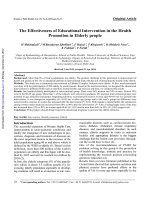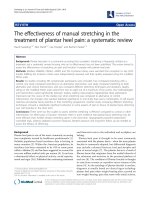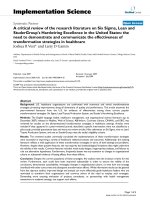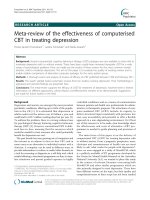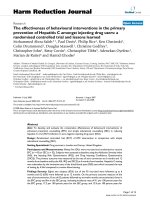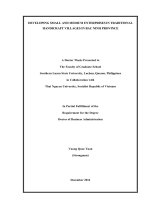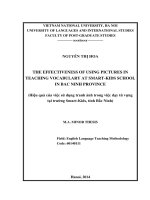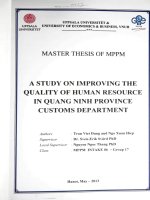THE EFFECTIVENESS OF USING PICTURES IN TEACHING VOCABULARY AT SMART-KIDS SCHOOL IN BAC NINH PROVINCE
Bạn đang xem bản rút gọn của tài liệu. Xem và tải ngay bản đầy đủ của tài liệu tại đây (196.07 KB, 19 trang )
VIETNAM NATIONAL UNIVERSITY, HA NOI
UNIVERSITY OF LANGUAGES AND INTERNATIONAL STUDIES
FACULTY OF POST-GRADUATE STUDIES
ϑ
NGUYỄN THỊ HOA
THE EFFECTIVENESS OF USING PICTURES IN
TEACHING VOCABULARY AT SMART-KIDS SCHOOL
IN BAC NINH PROVINCE
(Hiệu quả của việc sử dụng tranh ảnh trong việc dạy từ vựng
tại trường Smart-Kids, tỉnh Bắc Ninh)
M.A. MINOR THESIS
Field: English Language Teaching Methodology
Code: 60140111
HANOI - 2014
1
2
VIETNAM NATIONAL UNIVERSITY, HA NOI
UNIVERSITY OF LANGUAGES AND INTERNATIONAL STUDIES
FACULTY OF POST-GRADUATE STUDIES
ϑ
NGUYỄN THỊ HOA
THE EFFECTIVENESS OF USING PICTURES IN
TEACHING VOCABULARY AT SMART-KIDS SCHOOL
IN BAC NINH PROVINCE
(Hiệu quả của việc sử dụng tranh ảnh trong việc dạy từ vựng
tại trường Smart-Kids, tỉnh Bắc Ninh)
M.A. MINOR THESIS
Field: English Language Teaching Methodology
Code: 60140111
HANOI - 2014
ABSTRACT
Vocabulary is one of the important elements in teaching English. In
acquiring a foreign language, learning vocabulary is considered as one of important
tasks. At Smart-kids school, learning and teaching vocabulary is a major concern,
too. In an attempt to investigate the effect of pictures in teaching vocabulary the
study has been conducted in the form of an action research. The participation of the
study comprised 30 kindergarten students. They were randomly assigned into two
homogeneous groups each consisting of 15 learners. The experimental group used
pictures in teaching vocabulary but the control group didn’t use. The classroom
observation and tests were the main instruments employed for the data collection.
The result showed that the students in the experimental group outperformed the
students in the control group in their vocabulary knowledge. It means that the
contribution of pictures in teaching vocabulary to students led to higher level of
vocabulary improvement. Therefore, using pictures in teaching vocabulary seems to
be more effective than not using.
3
PART A: INTRODUCTION
Part A – Introduction- provides the background to the study and statement of
the problem, the aims, the research question, the scope of the study as well as the
research methodology. It also outlines the organization of the thesis.
1. Rationale of the study
English teaching involves four language skills: listening, speaking, reading
and writing. One of the main tasks assigned to foreign language teaching at school
is that of training students to be communicatively competent. Speaking is "the
process of building and sharing meaning through the use of verbal and non-verbal
symbols, in a variety of contexts" (Chaney, 1998: 13). In any second language
teaching and learning, speaking is always believed to be the most vital skill and in
teaching speaking, vocabulary is the most important thing. “If language structures
make up the skeleton of language, then it is vocabulary that provides the vital
organs and the flesh.”(Harmer 1993: 153). Cook’s (2000) conclusion is also
consistent with Wilkins in that “Grammar provides the overall patterns, vocabulary
the material to put into those patterns”. Or some authors, led by Lewis (1993) argue
that vocabulary should be at the center of language teaching, because ‘language
consists of grammaticalised lexis, not lexicalised grammar’. From the statement, it
can be seen that vocabulary functions as a cornerstone without which any language
could not exist. Speaking would be meaningless and perhaps impossible having
only structure without vocabulary. Therefore, the English teacher has to be able to
organize teaching and learning activities; they have to give materials by using a
suitable technique and master the lesson effectively. Especially in learning
vocabulary, teachers must make the students able to memorize such words in
English language and group of new words. Celce Maria stated that research in first
and second language acquisition suggest that initial teaching priorities for language
areas should be vocabulary, grammar, and pronunciation. Therefore, the English
teacher has to be able to organize teaching and learning activities and they have to
give materials by using a suitable technique and master the lesson effectively.
4
Especially in learning vocabulary, teachers must make the students able to
memorize such words in English language and group of new words. The statements
above mean, vocabulary is important to teach and teachers must try to find the most
effective way to help learners retain new words in long term memory.
As a teacher at Smart-kids schools, I realize that teaching vocabulary is
major concern because at the age of five, students cannot write or read and the
effective way to teach is through pictures. Therefore, I choose this topic to
understand more about the effectiveness of using picture in teaching vocabulary.
2. Aims and significance of the study
This study is aimed at finding out the effectiveness of using picture in
teaching vocabulary at Smart-kids school based on the understanding of vocabulary
and pictures in linguistic notion and the situation of teaching and learning there.
Through this, some implications to solve these problems will be suggested.
The result of the research will be helpful for many English teachers in many
schools especially Smart-kids school in Bac Ninh province. From this, the teachers
will find an effective ways and apply many activities in class to attract students
attention in learning new words. Basing on suggestions in this research, teachers
can have their own way to teach their students.
3. Scope of the study
I cannot go into details of all parts of language theory and practice because
of the limited time, the shortage of reference books, and the students’ language
ability. This is also a wide topic so I mainly focus on the effect of using picture in
teaching vocabulary in the field of memory, interest and interaction.
4. Research methodology
This methodology used in the study is those of an action research. Thus, it
applied both qualitative and quantitative approaches with two methods of data
collection. The qualitative data were collected from observation and the quantitative
data were collected from tests including two progress tests and one final test.
5
5. Organization of the study
This minor thesis is composed of three parts as follow:
Part A - Introduction: The first part presents rationale, aims and
significance as well as scope of the study, research methodology and organization
of the study.
Part B - Development: The second part consists of three chapters. Chapter 1
is for literature review, which provides the theoretical background of the study.
Chapter 2 is methodology which represents the research question, describes
informants and the design of the study. Chapter 3 presents the data analysis of
classroom observation and test then discussion.
Part C – Conclusion: The final part summarizes the major findings of the
experiment, voicing some implications for language teachers in teaching vocabulary
and suggesting some recommendations for further studies.
PART B: DEVELOPMENT
CHAPTER 1: LITERATURE REVIEW
In this chapter, relevant literature is reviewed, underlying the necessity and
the relevance of the study. In other words, background knowledge on vocabulary
teaching in general and vocabulary teaching through pictures in particular is looked
at critically to set up the theoretical framework for further investigation.
The first section of this chapter is devoted to theoretical aspects of
vocabulary teaching and the second section of this chapter is about pictures in
language teaching.
1.1. VOCABULARY TEACHING
1.1.1. Stages in vocabulary teaching
1.1.1.1. Presentation
The title of this stage indicates clearly its function is introducing new lexical
items to learners. As suggested by Thornbury (2002: 75-76) learners need to learn
both the meaning and the form of a new word. He also emphasizes some major
6
factors subject to the number of word to be presented such as: the learner’s level
(beginner, intermediate or advanced), learner’s likely familiarity with the words.
1.1.1.2. Practice
When the teacher presents the meaning of new words, they can only become
student’s passive vocabulary, and students may easily forget them and do not know
how to use properly. Students’ vocabulary can only be activated effectively if the
teacher gives the learners opportunities to practise them through vocabulary
exercises or activities.
1.1.1.3. Production
In this stage, students are advised to complete high-level tasks namely
production tasks (Thornbury, 2002: 100). He recommends that learners should
produce something as a product of their own. In this way, learners will turn words
from receptive to productive and put them into long-term memory.
1.1.1.4. Review
This process aims at helping students acquire active, productive
vocabularies. In the reviewing stage, students have more chance to use language
and receive feedback. It can be seen that games and communicative activities are
the best way to help students to review words. Besides, visual aids can make
vocabulary revision more interesting and effective.
1.1.2. Techniques in vocabulary teaching
Various techniques and activities are aimed directly at learning vocabulary,
which is usually put into sets of somehow related words, often by topic or meaning.
As McCarthy (1992) suggests, before presenting new language, pre-teaching
activities might be beneficial “to activate existing knowledge to make the encounter
with new words more meaningful” (McCarthy 1992: 108). Pre-teaching activities
often arouse students’ attention and desire to explore a particular topic or subject in
greater detail.
1.1.3. Factors affecting vocabulary retention
1.1.3.1. Memory
7
It can be seen that memory is important in learning new words. According to
Thornbury, 2002, there are two major types of memory: short term memory, long
term memory. Short term memory is the brain capacity to hold a limited number of
items of information for periods of time up to a few seconds. Long-term memory
can be seen as kind of filling system. This kind of memory has an enormous
capacity and its contents are durable over time.
1.1.3.2. Motivation
Theory on motivation can be seen from Littlewood’s perspective (1998: 53)
that “in second language learning as in every other field of human learning,
motivation is the crucial force which determines whether a learner embarks on a
task at all, how much energy he devotes to it, and how long he perseveres. It is a
complex phenomenon and includes many components: the individual’s drive, need
for achievement and success, curiosity, desire for stimulation and new experience,
and so on”. Keller (1984) (quoted in Ellis, 1994) sees 'interest' as one of the major
components of motivation, defining it as “a positive response to a stimuli based on
existing cognitive structures in such a way that learners’ curiosity is aroused and
sustained”.
1.1.3.3. Person-dependent factors
According to Lightbown and Spada (1999), person-dependent factors include
age, language aptitude, intelligence, attitude and personality. Rubin and Thomson
(1994) also consider the factors including age, aptitude, attitude, personality,
learning style and past experiences. In this thesis, these factors are considered in a
logical way to understand how they affect vocabulary acquisition in second
language acquisition.
1.2. PICTURES IN TEACHING VOCABULARY
1.2.1. The meaning of pictures
According to Cobuild (1987: 1320), a picture can be defined as “a visual
representation of image painted, drawn, photographed or otherwise rendered on a
flat surface.” Meanwhile, according to Andrew Wright (1989: 29), “Picture is not
8
just an aspect of method but through its representation of place, object, and people,
it is essential part of the overall experiences.”
1.2.2. The types of pictures
According to Brazyna Szyke (1981), pictures are divided into two main
types. The first type is that pictures of individual persons or thing may be used
mainly at the elementary level to introduce or test vocabulary items. For example, a
house, a dog, a man, a girl. The second type is that pictures of situations in which
person and object are “in action” between objects and people can be perfect
teaching aid for introducing or reviewing grammatical or structures. For example:
football, meeting, market.
1.2.3. Issues of using pictures in teaching vocabulary
In this part, many advantages and disadvantages of using pictures in teaching
vocabulary are considered. The use of pictures gives teachers a number of benefits.
It can be said that pictures are one of these valuable aids. They bring “images of
reality into the unnatural world of the language classroom” (Hill, 1990:1). Pictures
bring not only images of reality, but can also function as a fun element in the class.
However, using pictures in teaching language has their own limitation. That is, in
teaching vocabulary, pictures are not suitable or sufficient for demonstrating the
meaning of all words (Thornbury, 2004: 81).
1.2.4. Activities using pictures in teaching vocabulary
The benefit of using games in language teaching is absolutely clear. There
are many ways applying pictures in teaching vocabulary in classroom so it requires
careful considerations from language researchers and teachers. Also teachers need
to look deep into their class situations as well as their students’ background
knowledge and what items will be taught, too.
1.2.5. Review of previous studies on using pictures in teaching vocabulary
There are many studies which have been conducted on teaching vocabulary
through pictures. Firstly, a M.A minor thesis named “using pictures in teaching
vocabulary of English to the second year students of Mechanical department at Hai
9
Phong Industrial Vocational College” by Nguyen Thi Thu Hoa in 2010. Secondly,
the thesis by Khuong Ha Linh, in 2011 named “the exploitation of pictures in
teaching vocabulary according to communicative approach for first year students at
Vietnam National University, Hanoi University of Economics and Business”.
CHAPTER 2: METHODOLOGY
This chapter discusses in detail the research methodology of the research as
well as the design of the research. This research was conducted in the form of an
action research basing on the following model by Kemmis and Mc Taggart (in
Burns, 1999: 32) with four steps. In this chapter, the research question is raised and
then informants are shown in detail. After that, the design of the study is shown
with four steps of action research including planning, acting, observing and
reflecting.
2.1. Research question
This study attempts to examine the effectiveness of using pictures in terms of
students’ English learning. The research question is:
Is using pictures in teaching vocabulary more effective than not using
pictures?
2.2. Informants
In the study, 30 kindergarten students dividing into 2 groups: the control
group and the experimental group at Smart-kids school in Bac ninh province were
employed as the participants of the research. The research time is two months in 8
periods. The researcher taught two classes the same content but in two different
ways for the vocabulary teaching. With the experimental group, the researcher
taught vocabulary using pictures but the control group received traditional
treatment. In each period, the researcher had to observe children and after 8 periods,
children took a test to check vocabulary they had learnt.
2.3. Planning
In this thesis, basing on Kemmis’s model, two classes were assigned to an
experimental group and a control group. The researcher taught the two classes the
same content but in two different ways for the vocabulary teaching. In addition, 8
10
lesson plans were prepared for 8 weeks basing on the topic and the demanded new
words in the textbook: Super Kids 1.
2.4. Acting
In this study, pictures were used in teaching vocabulary. Below is my detail
action on each week with the name of the unit, kind of pictures, games and teaching
activities: pair work, group work in 8 weeks:
2.5. Observing
As being suggested, the effects of using pictures in teaching vocabulary were
observed in the treatment group and teaching and learning process in the control
group each week.
2.6. Reflecting
In carrying out the final step, the result of how the teaching learning process
runs was reflected. It means that the observation notes were collected each week
then they were classified and evaluated throughout the research
CHAPTER 3: DATA ANALYSIS AND DISCUSSION
In this chapter, all collected data from classroom observation and tests will
be analyzed and discussed to reveal the answers to the research question
3.1. Classroom observation
3.1.1. Memory
During treatment time, number of words that students remembered after each
unit was really important indicator to find out the effectiveness of using pictures in
teaching vocabulary in the experimental group compared with the control group.
Numbers of students remembered from 1 word to 4 words were recorded but to see
clearly the differences, number of students with the percentage of them remembered
three and four words were shown in table below:
Group
Week
The control group The experimental group
Number of students
remember 3 and 4 words
%
Number of students
remember 3 and 4 words
%
Week 1 6 40 10 66.7
11
Week 2 7 46.7 10 66.7
Week 3 9 60 11 73.3
Week 4 7 46.7 10 66.7
Week 5 7 46.7 11 73.3
Week 6 7 46.7 14 93.3
Week 7 8 53.3 13 86.7
Week 8 9 60 14 93.3
Table 1: The number of students remembers 3 and 4 words
Table 1 shows clearly the difference in the students’ understanding of the
lessons in the control group and the experimental group during 8 weeks. It could be
seen from the table that number of students remembered 3 and 4 words in the
experimental group was much higher than that in the control group.
3.1.2. Interest.
During 8 weeks of teaching, student’s participation in learning activities was
taken notes in chart below:
Chart 1: The students’ participation in class
Chart 1 showed that, in every week, students in the experimental group
joined learning activities more than that in the control group. As it was observed,
the children had very positive attitudes and reactions when the teachers used
pictures in teaching new words. Obviously, the presence of visuals played a
significant role in this activity. Its importance lied in the fact that all students tended
to watch them for the whole time, even if it was not their turn – they were usually
interested if a member of their team touched the correct picture. In addition, many
12
pictures of students in joining learning activities were taken to show the learning
atmosphere in the treatment group.
3.1.3. Classroom interaction
The classroom interaction in the control group was much different from that
in the experimental group. The difference could be shown clearly in the following
chart:
Chart 2: Classroom interaction
It can be seen from the chart that, the frequency of teacher-learner interaction
and learner-learner interaction in both group was much different. Students in the
experimental group interacted with the teacher and students together much more
students in the control group.
3.2. Test result
3.2.1. The progress tests
After marking, the means of the tests were calculated and presented as
follow:
Group
Control group Experimental group
Progress
Test 1
Progress
Test 2
Progress
Test 1
Progress
Test 2
MEAN
6.13 6.6 6.5 7.8
Table 2: The progress tests
From these numbers, it can be concluded that pictures or other teaching
method did help students remember the word meaning in a short time. Moreover,
the gap between students’ scores in both groups is quite, so we can say using
pictures seem to be better for students to remember new words.
13
3.2.2. The final test
In the following chart, the result of the final test in both groups was shown as
follows:
Chart 3: The final test
In conclusion, it seems that using pictures in teaching vocabulary has a
positive effect on students’ learning progress.
3.3. Finding and comments
From the discussion above, some major findings can be drawn out as two
main points as follow: the improvement of students’ vocabulary mastery and the
improvement of students’ participation in class.
The experimental group students in the present study were shown explicitly
the vocabulary picture strategy which they could try to achieve better vocabulary
learning. Thus, this kind of new teaching method seemed to help them to learn
better new words. The vocabulary instruction through pictures empowered Smart-
kids students in learning the relevant vocabulary.
In the observation process, students’ enthusiastic and motivation increased in
joining learning activities in both groups. However, unlike the control group
students, the students in the experimental group were free to interact with each
other. Students in the experimental group seemed to benefit from this kind of
learning, as they enlarged their vocabulary knowledge at the end of the study.
Results showed that students learned better the relevant words.
PART C: CONCLUSION
14
In this part, the author intends to present the outcome of the whole thesis by
summing up the findings, limitations as well as putting forward several suggestions
for further studies.
1. Conclusion
As mentioned previously, this thesis aimed at exploring the effectiveness of
pictures in teaching vocabulary to kindergarten students. The result of the study
shows that using pictures in teaching vocabulary was more effective in helping
students in acquiring new words particular in memory, interest and interaction.
Firstly, from the observation process, using pictures in teaching vocabulary
enhanced memory of students in the experimental group than that in the control
group.
Secondly, using pictures in teaching vocabulary promoted students in the
treatment group to be interested in participating in the learning activities more than
those on the control group so the classroom situation became active and interactive
because they enjoyed and they were motivated in learning new words.
Besides, the students in the experimental group had stronger classroom
interaction and more communicative skills than those in the control group.
From the result of the test, it can be seen that the experimental group students
had significantly better vocabulary gain scores than the control group students at the
end of the study. The findings revealed that participants in the experimental group,
who had received the treatments on using pictures in teaching vocabulary,
significantly enhanced better performance in a vocabulary test. In term of
techniques, it can be said that using pictures especially flash card is a useful way of
enhancing vocabulary learning especially the kindergarten students at Smart-kids
school. Thus, based on the results, it can be concluded that using pictures in
teaching vocabulary seems to be more effective than not using picture.
2. Implications
15
On the basis of the findings of the study, the author would like to give some
recommendations on English vocabulary teaching and learning for high school
learners.
Firstly, using pictures in teaching vocabulary to kindergarten students is
really effective because it is suitable with their age. In addition, kindergarten
students tend to like visual thing and be attracted by colorful and well-designed
learning aids.
Secondly, word games should be used more frequently as an effective way to
help students learn new words general as well as recall words after a period of time
in particular. Teaching vocabulary through pictures needs to change in different
ways to attract more students. Holding small activities using pictures is able to
develop a good atmosphere in the class, so that the students learn at a comfortable
situation. Besides the textbook need having more game and teacher can design
many suitable games to teach students
Last but not least, to make highest use of pictures, it is necessary for the
teachers to use other interesting techniques and media such as pictures, so students
can be encouraged themselves to learn more, ask more and to know more
3. Limitations and recommendations for further studies
Despite considerable efforts of the researcher, certain limitations could be
detected in this study due to time constrain and other unexpected factors
Firstly, the research was carried out in a short period of time in only 8 weeks
because it was feared that if the study had taken longer time, it might have affected
the syllabus. Secondly, the size of the study is rather small with only 30 students of
two classes. Therefore, the results found from the research cannot be highly
generated. Finally, the kindergarten students are so young that the researcher had
many difficulties in testing and could not use other method of data collection as
questionnaires and interview.
However, it was noteworthy that these above short-comings should always
be taken into consideration when further studies are conducted in the future.
16
Though this is just a small-scaled study on the issue, it may provide some helpful
suggestions for other teachers. However, for further studies, the researcher would
like to give following suggestions. Firstly, in this study, vocabulary flash card was
used to teach vocabulary to Smart-kids students. In another research, it can be used
to teach other components of the language, such as grammar. Secondly, interested
researchers can investigate the impact of one specific type of pictures such as flash
card or wall chart.
REFERENCES
1. Andrew Wright. (1989). Picture for Language, learning. Cambridge
Handbook for Language Teachers. Cambridge University Press.
2. Betty Morgan Bowen. (1973). Look Here!, Visual Aids In Language
Teaching, London: essential Language- Teach Series.
3. Brazna Szyke. (1981). Using Pictures as Teaching Aids;(English Teaching
Forum, Vol.XIX,No.4
4. Brown, H.D. (2000) Principles of Language Learning and Teaching. (4th
edn.) New York: Longman (Formerly New Jersey: Prentice Hall).
5. Burns, A. (1999). Collaborative action research for English teachers.
Cambridge: Cambridge University Press.
6. Celce Maria. (1987). Current Perspective on Pronunciation: Practice
Anchored in Theory. Washington DC: Teachers of English to Speaker of
Other Languages
7. Chaney, A.L., and T.L. Burk. 1998. Teaching Oral Communication in
Grades K-8. Boston: Allyn&Bacon.
8. Cobuild, C. (1987). English Language Dictionary. Cambridge: Cambridge
University Press.
9. Cook, G. (2000). Language Play, Language Learning. Oxford University
Press.
10. Doff, A. (1988). Teaching English: A training course for teacher-trainer’s
handbook. Cambridge: Cambridge University Press.
11. Ellis, R. (1994). The Study of Second Language Acquisition. Oxford: Oxford
University.
12. Ellis, Rod. (1985). Understanding Second Language Acquisition. Oxford,
England: Oxford University Press.
17
13. Gairns, R., & Redman, S. (1986). Working with words: A guide to teaching
and learning vocabulary. Cambridge: Cambridge University Press.
14. Harmer, J. (1993). The Practice of English Language Teaching. Essex:
Longman Group UK Limited.
15. Hunt, A. & Beglar, D. (2002). Current research and practice in teaching
vocabulary learning. In J.C. Richard & W.A. Renandya. Cambridge:
Cambridge University Press.
16. Kemmis, S.,& Mc Taggart, R. (1988a). The action research planner (3
rd
ed.). Geelong, Australia: Deakin University Press.
17. Kemmis, S.,& Mc Taggart, R. (1988b). The action research reader (3
rd
ed.).
Geelong, Australia: Deakin University Press.
18. Lewis, M. (1993). The lexical approach. Hove: Language Teaching
Publications.
19. Lightbown, P. M. and Spada, N. (1999). How Languages are Learnt. (2nd
edn.) Oxford: OUP.
20. McCarthy, Michael.1990. Vocabulary. Oxford: Oxford University Press.
21. Rogers, A. & Horrocks, N. (2010). Teaching adults. Berkshire: Open
University Press.
22. Schmitt, N. (1997). Vocabulary learning strategies. In N. Schmitt & M.
McCarthy (Eds.), Vocabulary: Description, acquisition and. Cambridge:
Cambridge University Press.
23. Spolsky, B. 1989. Conditions for Second Language Acquisition, Oxford:
Oxford University Press.
24. Stern, H.H. 1983. Fundamental Concepts of Language Teaching. Oxford:
Oxford University Press.
25. Thornbury, S. (2002). How to teach vocabulary. New York: Prentice Hall.
26. Thornbury, S. (2004). How to teach vocabulary. New York: Prentice Hall.
27. Vernon,S,Gerlach and Donald P.Emily. (1980). Teaching and Media a
Systematic Approach (New Jersey: Prentice Hall)
28. Williams, M. & Burden,R. (1997). Psychology for language teachers.
Cambridge: Cambridge University Press.
29. Wright, Andrew. Pictures for Language Learning. Cambridge: Cambridge
University Press, 1990. ISBN 0-521-35800-0.
30. />18
